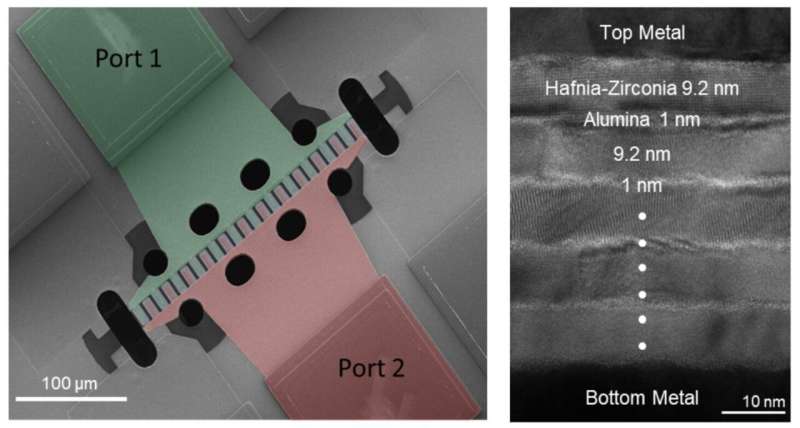August 2, 2023 feature
This article has been reviewed according to Science X's editorial process and policies. Editors have highlighted the following attributes while ensuring the content's credibility:
fact-checked
peer-reviewed publication
trusted source
proofread
Nanoelectromechanical resonators based on hafnia–zirconia–alumina superlattices with gigahertz spectrum coverage

Newly developed atomic engineering techniques have opened exciting opportunities for enabling ferroelectric behavior in high-k dielectrics, materials that have a high dielectric constant (i.e., kappa or k) compared to silicon. This could in turn inform the development of more advanced CMOS-based technology with a broader range of functions or properties.
Researchers at the University of Florida have recently been exploring the potential of atomically engineered hafnia and zirconia-based materials for creating different components for electronic systems. In a recent Nature Electronics paper, they introduced new wide spectrum nanoelectromechanical resonators, electronic components that can generate a resonant frequency, based on hafnia–zirconia–alumina superlattices.
"My research group has been the pioneer in exploring atomically engineered ferroelectric hafnia–zirconia as a nanoscale integrated transducer for new CMOS-based Nanoelectromechanical systems (CMOS-NEMS) paradigms, with transforming impact in clock generation, physical sensing, spectral processing, and computing applications," Roozbeh Tabrizian, the principal investigator who led the study, told Phys.org. "For all these applications, the effectiveness of NEMS operation is essentially set by the efficiency of piezoelectric coupling in hafnia–zirconia film."
Hafnia–zirconia films have a complex polycrystalline structure that consists of domains with different polar and nonpolar morphologies, each of which contributes to electromechanical coupling depending on electric and mechanical boundary conditions. Due to this intricate structure, the fundamental physical processes underpinning piezoelectricity in these materials remain poorly understood, which makes enhancing this property challenging.
"When specifically targeting the use of hafnia–zirconia films to create ultra- and super-high-frequency resonators, the piezoelectric coupling of the film at such high frequencies is a key measure that set the performance and identify their applicability for creation of clocks and filters," Tabrizian said. "To answer these questions, we decided to develop experiments to unlock the evolution of piezoelectric coupling in hafnia–zirconia during electrical polling."
As part of their recent work, Tabrizian and his colleagues tried to use material engineering approaches to enhance piezoelectric coupling (i.e., an effect that entails an interaction between mechanical and electrical physics) in hafnia–zirconia–alumina superlattices. Finally, they used the material they engineered to create nanoelectromechanical resonators that could be integrated in various CMOS-based electronic devices.
"Our hafnia–zirconia–alumina nanoelectromechanical resonators have three unique features," Tabrizian said. "The first is their inherent CMOS compatibility and the availability of constituent materials at the front-end of CMOS process highlights a transforming potential for monolithic integration of them with solid-state circuits. This enables creation of clocks, filters, sensors, and mechanical computers that are orders of magnitude higher in performance and power efficiency and lower in size and cost."
A second advantage of the resonators created by Tabrizian and his colleagues is that they can be easily scaled to super and extremely high frequencies, as the hafnia–zirconia films they are based on can be shrunk significantly. Notably, when scaled down to a few nanometers, the films engineered by the researchers retained their large piezoelectric coupling.
As a result, these films could be used to create many different CMOS-integrated devices, including resonators, clocks and filters that operate at tens of gigahertz. These high-frequency CMOS-integrated systems will be crucial to develop next generation wireless communication technologies.
"Third and last, benefiting from ferroelectric behavior, the piezoelectric coupling in hafnia–zirconia can be switched on and off by temporary application of a DC voltage," Tabrizian explained. "This enables the creation of frequency control devices that are intrinsically switchable, which obviates the need for external switches and their power consumption, loss, and footprint overhead. This is crucial when targeting extension of system to multi-frequency multi-band operation that requires agile configuration within an array of resonators with different frequencies."
The recent work by this team of researchers enhances the present understanding of how piezoelectric coupling evolves in hafnia–zirconia transducers, switching from the nonlinear quadratic regime in as-deposited films to the linear regime required to create frequency control systems. This switching spontaneously occurs when the engineered hafnia–zirconia films are exposed to sufficient electric-field cycling.
"Our study also highlights the potential of using thin alumina interlayers within hafnia–zirconia transducer (i.e., creating the hafnia–zirconia–alumina superlattice) to enhance piezoelectric coupling of the transducer, and sustain this coupling even once the films are released from substrate to form levitating membranes," Tabrizian said. "With this knowledge, we shed light on the manufacturing approach for creation of high-performance hafnia–zirconia–alumina resonators that operate with high quality factor and coupling in ultra- and super-high frequencies."
So far, Tabrizian and his colleagues have successfully used their films to develop high-performance resonators with a coverage spanning between 0.2–20 GHz frequencies. In their next studies, however, they plan to explore the potential of the films to create other electronic components, while also integrating and testing the resonators they created in various microsystems.
"A key direction for our future research will be the integration of the developed hafnia–zirconia–alumina nanoelectromechanical resonators on CMOS chips to create the first super-high-frequency monolithic CMOS-NEMS oscillator," Tabrizian added. "In addition, we will target exploration of methods for temperature-stabilization of hafnia–zirconia–alumina resonators through material engineering. This is essential for realization of stable oscillators for clock and frequency reference-generation applications."
More information: Troy Tharpe et al, Nanoelectromechanical resonators for gigahertz frequency control based on hafnia–zirconia–alumina superlattices, Nature Electronics (2023). DOI: 10.1038/s41928-023-00999-9
Mayur Ghatge et al, An ultrathin integrated nanoelectromechanical transducer based on hafnium zirconium oxide, Nature Electronics (2019). DOI: 10.1038/s41928-019-0305-3
Journal information: Nature Electronics
© 2023 Science X Network





















